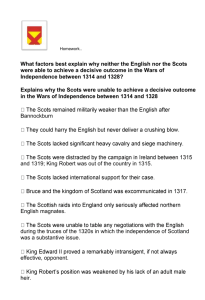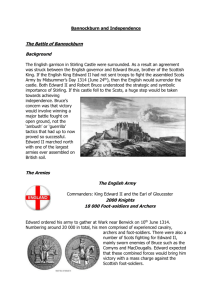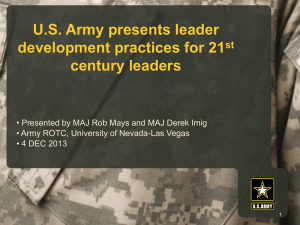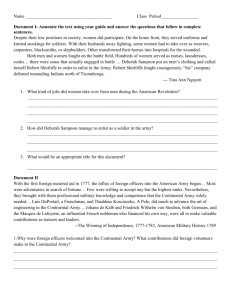04-02-2014 - Deans Community High School
advertisement
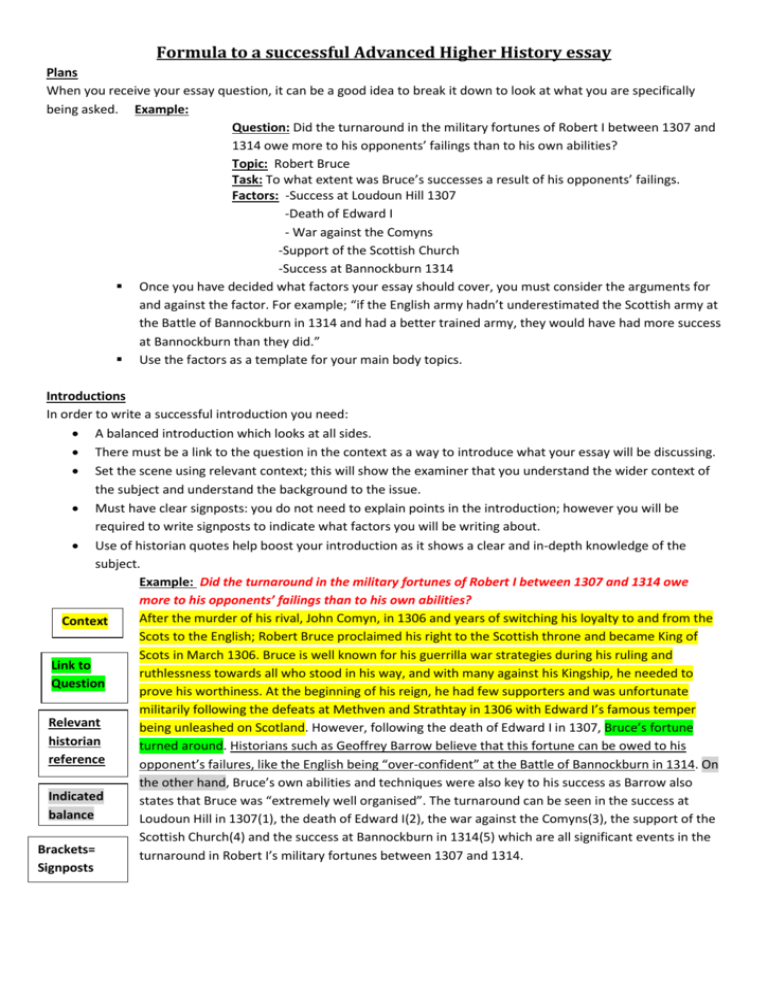
Formula to a successful Advanced Higher History essay Plans When you receive your essay question, it can be a good idea to break it down to look at what you are specifically being asked. Example: Question: Did the turnaround in the military fortunes of Robert I between 1307 and 1314 owe more to his opponents’ failings than to his own abilities? Topic: Robert Bruce Task: To what extent was Bruce’s successes a result of his opponents’ failings. Factors: -Success at Loudoun Hill 1307 -Death of Edward I - War against the Comyns -Support of the Scottish Church -Success at Bannockburn 1314 Once you have decided what factors your essay should cover, you must consider the arguments for and against the factor. For example; “if the English army hadn’t underestimated the Scottish army at the Battle of Bannockburn in 1314 and had a better trained army, they would have had more success at Bannockburn than they did.” Use the factors as a template for your main body topics. Introductions In order to write a successful introduction you need: A balanced introduction which looks at all sides. There must be a link to the question in the context as a way to introduce what your essay will be discussing. Set the scene using relevant context; this will show the examiner that you understand the wider context of the subject and understand the background to the issue. Must have clear signposts: you do not need to explain points in the introduction; however you will be required to write signposts to indicate what factors you will be writing about. Use of historian quotes help boost your introduction as it shows a clear and in-depth knowledge of the subject. Example: Did the turnaround in the military fortunes of Robert I between 1307 and 1314 owe more to his opponents’ failings than to his own abilities? After the murder of his rival, John Comyn, in 1306 and years of switching his loyalty to and from the Context Scots to the English; Robert Bruce proclaimed his right to the Scottish throne and became King of Scots in March 1306. Bruce is well known for his guerrilla war strategies during his ruling and Link to ruthlessness towards all who stood in his way, and with many against his Kingship, he needed to Question prove his worthiness. At the beginning of his reign, he had few supporters and was unfortunate militarily following the defeats at Methven and Strathtay in 1306 with Edward I’s famous temper Relevant being unleashed on Scotland. However, following the death of Edward I in 1307, Bruce’s fortune historian turned around. Historians such as Geoffrey Barrow believe that this fortune can be owed to his reference opponent’s failures, like the English being “over-confident” at the Battle of Bannockburn in 1314. On the other hand, Bruce’s own abilities and techniques were also key to his success as Barrow also Indicated states that Bruce was “extremely well organised”. The turnaround can be seen in the success at balance Loudoun Hill in 1307(1), the death of Edward I(2), the war against the Comyns(3), the support of the Scottish Church(4) and the success at Bannockburn in 1314(5) which are all significant events in the Brackets= turnaround in Robert I’s military fortunes between 1307 and 1314. Signposts Main body tips: Each main body paragraph should open by introducing the line of argument for the paragraph. Development in the main body should be focused on the question asked. It should not be a narrative of what happened. Make sure what your saying is relevant to what has been asked. For example, if a question is about a specific time period (1307-1314) it is important that all recall is from this period. Always be sure to check dates in the question so you don’t get caught out. As there are 25 marks available for knowledge, historical interpretation and analysis. It is a good idea to write an argument for each recall point and at the end of each topic paragraph to argue what it means to the question. Like a mini conclusion of the point you have made! For example: “Within Scotland, lack of co-ordination between the Comyns’ and poor decision making also led to their own downfalls against Robert I and the underestimation of his ability and his army. Therefore, it can be argued that both the military ability of Robert I and the failure and misfortune of his enemies contributed towards the overall military turn around in favour of the Scots between 1307 and 1314.” Argument should be directly linked to the question and supported by evidence as shown above. It shows that you have considered the meaning behind the decisions. Use of argument should be consistent and balanced throughout the essay. Historian’s interpretations and quotes are required; they are good sources of recall as it shows an awareness of other views and debates on the issue. Conclusions: In order to write a successful conclusion you need: Start by giving a balanced sentence such as; “To conclude, prior to 1307, Robert I had very little support from his Kingdom and had not been successful at leading his army in 1306 against the Comyns and their rivals, nor at the battles at Methven or Strathsay.” Use the phrase “on the one hand” to sum up the key arguments for one side of the argument. Use the phrase “on the other hand” to then sum up the counter-arguments. Give an “overall” judgement on the question. Example: To conclude, prior to 1307, Robert I had very little support from his Kingdom and had not been successful at leading his army in 1306 against the Comyns and their rivals, nor at the battles at Methven or Strathsay. However, between 1307 and 1314 Robert I arguably was met with good military fortune which resulted both from his own developments in military tactics as well as the failings of his enemies. On the one hand, Robert I focused on raising his support within Scotland and thus successfully built up an army of supporters, he trained his army, arguably used guerrilla techniques on the battlefront but also used strategies and plans prior to the battles which outsmarted the enemy; best seen during the Battle of Bannockburn where Robert I successfully planned a trap which the English army, despite its greater size, fell for and inevitably lost the battle. This proved that Robert I had improved military tactics which evidently had a great impact in the turnaround in fortune between 1307 and 1314 and the Scottish Kingdom had full confidence and accepted him as rightful king of Scots by 1314. However, on the other hand, a major contribution to the turnaround in military fortune was the death of Edward I, the driving force behind the Wars of Independence who was replaced with Edward II who did not have the same passion or leadership skills as his predecessor. Within Scotland, lack of co-ordination between the Comyns’ and poor decision making also led to their own downfalls against Robert I and the underestimation of his ability and his army. Therefore, it can be argued that both the military ability of Robert I and the failure and misfortune of his enemies contributed towards the overall military turn around in favour of the Scots between 1307 and 1314.
